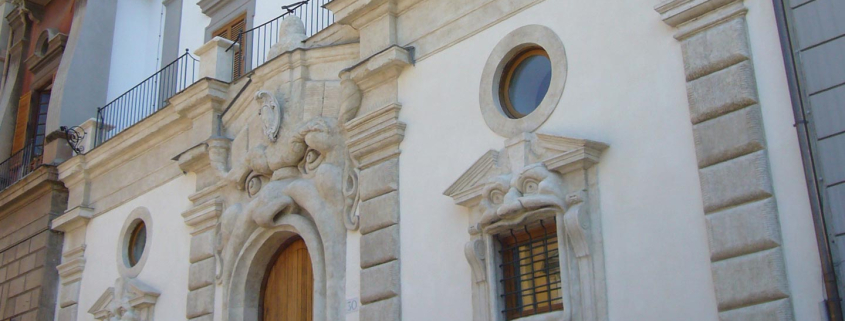Integration of easydb into interdisciplinary scientific research projects at the Bibliotheca Hertziana
Project description and challenges in data management before using easydb .
This article offers an insight into the practical use of easydb at the Bibliotheca Hertziana - Max Planck Institute for Art History, an institute specializing in art historical research. Under the direction of Prof. Dr. Tristan Weddingen easydb was enable individual research data management This initiative particularly supports projects that focus on global art history with a focus on Latin American art and architecture, and allows flexible handling of research data outside of the institutional database structures that primarily record Italian works of art.
Prof. Dr. Tristan Weddigen is a renowned art historian and managing director of the Department of Modern Art History at the Bibliotheca Hertziana. He researches topics such as iconology of textiles, art history and the relationship between art and space, has published key works such as Wölfflin's “Art History Basic Terms” and has headed the BHMPI since 2017. There he promotes projects that deal with Italian art networking, modern art research and digital art history. Prof. Dr. Weddingen is also involved in leading art history organizations and educational initiatives, where he uses his expertise and contributes to the further development of art history on a global scale.
Collections created using easydb on the initiative of Prof. Dr. Weddingen were created
- Art and architecture in Argentina (590 objects, as of February 2024)
- Art and architecture in Peru (1,600 objects, as of February 2024)
- Art and architecture in Brazil (4,428, as of 02/2024)
- Art and Architecture of the Philippines (2,375, as of 02/2024)
Choosing easydb compared to other solutions
Prof. Dr. Weddingen chose easydb because he was already familiar with the system through previous work and had had good experiences dam it. The decision was based on easydb 's ability to meet specific needs of its research, particularly the flexible management and expansion of research data. He needed a system that made it possible to develop his own research projects independent of the institutional collections, with a particular focus on global art history and projects outside the traditional focus. easydb provided the technological infrastructure needed to use data in an expanded, connected way that goes beyond just image storage and enables integration into more complex research contexts such as knowledge graphs.
Implementation challenges and solutions
When implementing easydb Prof. Dr. Weddingen faced relatively few challenges, mainly because the decision was made to have the instances hosted by Programmfabrik , which relieved the burden on staff. An effective solution to overcome the initial challenges was to set up a regular meeting with a project manager from Programmfabrik during the first two years. These regular meetings made it possible to clarify many questions and make necessary adjustments.
The regular meetings focused on adapting a specifically developed ontology and efficiently fixing bugs, which contributed significantly to the successful implementation and customization of easydb .
Crucial functions of easydb in the project
Prof. Dr. Tristan Weddigen rates the following key functions of easydb as particularly important because they enable specialized and efficient management of complex data structures.
- Metadata Management easydb 's ability to process and manage complex metadata is critical to the project. This feature makes it possible to expand the data beyond simple image info and make it available for comprehensive scientific analysis and reuse in other systems.
- Integration into knowledge graphs : The ability easydb data into knowledge graphs is particularly valuable as it allows expanded, networked use of research data and thus enriches the research infrastructure.
- International standards support : easydb 's compatibility with international nomenclatures and standards facilitates global collaboration and data sharing by enabling unified and consistent data management and search .
- Rights management : The rights management functions of easydb are essential for the project as they enable differentiated access control and thus ensure the security and integrity of the data.
Improvements that resulted from the use of easydb in the project
The use of easydb has resulted in several significant improvements for Prof. Dr.'s project. Weddings result in:
- Sustainability and seriousness: The use of easydb has led to a more sustainable and serious research environment. The platform enables long-term and secure storage of research data, ensuring the integrity and availability of the data for future generations of research.
- Research-oriented data management easydb 's specialized functions support research-oriented data management, which makes it possible not only to store data, but also to use it meaningfully in a scientific context. This promotes deeper scientific analysis and increases the value of the data to the academic community.
- Promoting Open Science: The use of easydb supports the principles of Open Science by facilitating the sharing and access of research data. This opens up new opportunities for collaboration and helps accelerate scientific discoveries.
- Improving data accessibility: Structuring and cataloging research data in easydb improves its accessibility, increasing research efficiency and expanding data reuse opportunities.
Conclusion
This use case illustrates the flexibility and efficiency of easydb as a data management solution for academic research institutions that want to manage their data assets specifically, securely and sustainably. It highlights easydb 's ability to adapt to the diverse and evolving needs of scientific research projects, while providing comprehensive support for data archiving, analysis and use.
WOULD YOU LIKE TO LEARN MORE ABOUT THE EASYDB SUCCESSOR VERSION FYLR ?
Visit the fylr website fylr for more Info . search
We look forward to exchanging ideas with you!
Image source: Wikimedia Commons. March 20, 2024. Campo Marzio – Palazzetto Zuccari su via Gregoriana. Retrieved from http s://commons.wikimedia.org/wiki/File:Campo_Marzio_-_palazzetto_Zuccari_su_via_Gregoriana_1230300.JPG#/media/File:Campo_Marzio_-_palazzetto_Zuccari_su_via_Gregoriana_1230300.JPG



